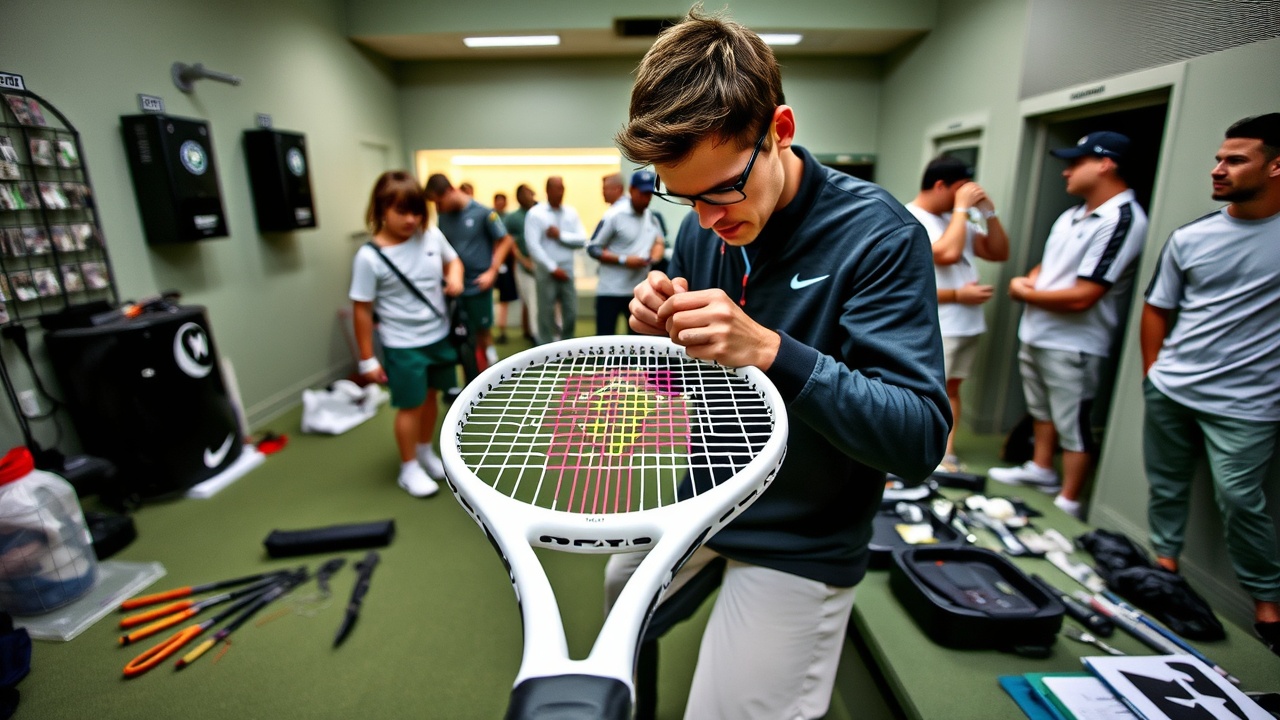Wimbledon Opening Day: A Unique Role
At the prestigious All England Club in London, the thrill of Wimbledon’s opening day saw Ed Day, a student from the outskirts of the city, covering a remarkable distance of 17.5 kilometers. His task was to shuttle between the venue’s stringing center—adjacent to the players’ practice courts—and the various competition courts to deliver rackets to players requiring restringing during their matches. Adorned in a bright vest, Day navigated through enthusiastic crowds, juggling the demands of his unique role.
“This one is for Anastasia Zakharova, that one’s for Luciano Darderi,”
he noted, explaining that while there exists an exclusive tunnel leading to No. 3 Court, his work often entails weaving through swarms of spectators thereafter.
Memorable Experiences and Stringing Statistics
Reflecting on his past experience at Wimbledon, Day recalled the thrill of hand-delivering a racket to Emma Raducanu. Meanwhile, Mark Petchey, coaching Raducanu this year, was seen collecting three rackets before her second-round match against Markéta Vondroušová. Each racket delivered is meticulously documented, specifying the required string type and tension, as the old strings are replaced by skilled stringers readying them for play. On the tournament’s inaugural day alone, 50 rackets were restrung mid-match, contributing to a substantial total of 664 restrings requested by the players before or after their games. Last year, the total number of rackets serviced by the stringing center, operated by Babolat, climbed to an impressive 6,400, up from 6,188 in the previous tournament.
The Stringing Team and Their Expertise
Babolat has a dedicated team of 25 stringers who work tirelessly using 23 machines from early morning until shortly after the live matches conclude. Among these stringers on day three was Paul Skipp from Portsmouth, a veteran in the field with two decades of Wimbledon experience under his belt, and a long list of renowned clients including Andy Murray and Carlos Alcaraz.
“I’ve strung a racket in probably 10-and-a-half minutes,”
he stated while expertly restringing Tommy Paul’s racket. On a typical day, he averages about 17 minutes per racket, ensuring that each player remains consistent with their preferences, particularly when they require subtle adjustments to string tension. Skipp noted that while top players generally make straightforward requests, those further down the rankings sometimes have more peculiar demands regarding aesthetics and string tension settings.
Finishing Touches and String Selection
Manuela Villa Topple, a member of the logo application team, adds the finishing touches to the rackets, applying stencils and paint that reflect each player’s sponsorship deals.
“After the rackets are strung, we apply the logos with solvent paint,”
she elaborated. This step requires vigilance, as any error—especially with natural gut strings—could necessitate a complete restring. The string theory goes beyond aesthetics; it encompasses materials like natural gut, multifilament, and polyester, each offering distinct performance characteristics—natural gut being the most luxurious but costly, multifilaments offering a balance, while polyesters are recognized for their durability and spin potential.
Tension Adjustments and Player Preferences
In addition to string selection, players must also choose the appropriate tension for their rackets, which typically range from 21 kg (46 lbs) to 25 kg (55 lbs). Uncommon adjustments, sometimes as low as 8.6 kg (19 lbs) like for Adrian Mannarino, reflect personalized playing styles. Tension adjustments can also correspond to environmental factors, particularly during hot weather, where tighter strings compensate for the lively tennis balls and grass conditions.
Customizations and the Role of the Stringing Center
Throughout the tournament, players often use multiple rackets strung to varying tensions, and customizations extend beyond strings. They also seek specific logo placements on their rackets, as evidenced by unique preferences expressed by players like Iga Świątek and Kateřina Siniaková, or even the unconventional choices of logo-free appearances by certain pairs in the mixed doubles event.
The Babolat stringing center, having serviced over 700 players since they took over this responsibility in 2022, continues to play an indispensable role in the grand spectacle of Wimbledon. Yet, not all elite players engage with this service; for instance, Djokovic has his own private stringing setup. As the day draws closer to the final matches, the once frantic atmosphere begins to settle into a routine, but Day and the rest of the stringing team remain ever-ready, vigilant for any last-minute requests from the stars as they prepare for key moments in their careers.




